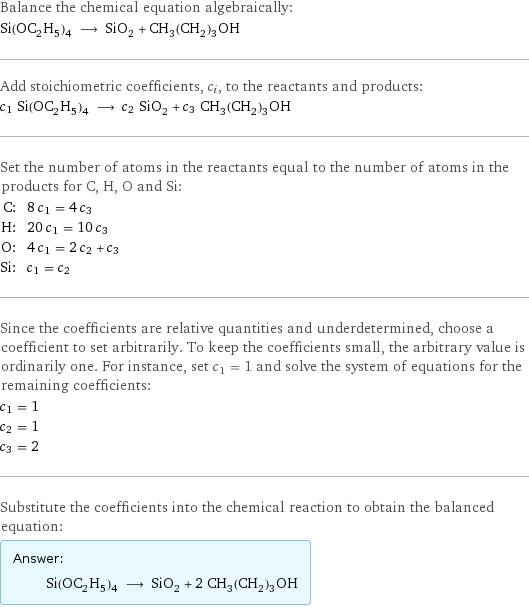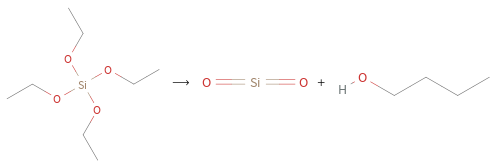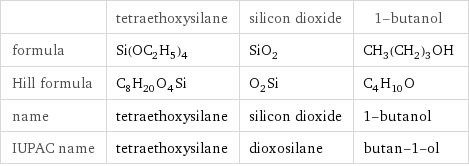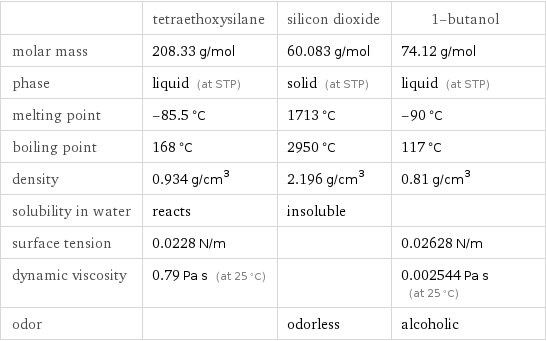Input interpretation

Si(OC_2H_5)_4 tetraethoxysilane ⟶ SiO_2 silicon dioxide + CH_3(CH_2)_3OH 1-butanol
Balanced equation

Balance the chemical equation algebraically: Si(OC_2H_5)_4 ⟶ SiO_2 + CH_3(CH_2)_3OH Add stoichiometric coefficients, c_i, to the reactants and products: c_1 Si(OC_2H_5)_4 ⟶ c_2 SiO_2 + c_3 CH_3(CH_2)_3OH Set the number of atoms in the reactants equal to the number of atoms in the products for C, H, O and Si: C: | 8 c_1 = 4 c_3 H: | 20 c_1 = 10 c_3 O: | 4 c_1 = 2 c_2 + c_3 Si: | c_1 = c_2 Since the coefficients are relative quantities and underdetermined, choose a coefficient to set arbitrarily. To keep the coefficients small, the arbitrary value is ordinarily one. For instance, set c_1 = 1 and solve the system of equations for the remaining coefficients: c_1 = 1 c_2 = 1 c_3 = 2 Substitute the coefficients into the chemical reaction to obtain the balanced equation: Answer: | | Si(OC_2H_5)_4 ⟶ SiO_2 + 2 CH_3(CH_2)_3OH
Structures

⟶ +
Names

tetraethoxysilane ⟶ silicon dioxide + 1-butanol
Equilibrium constant
![Construct the equilibrium constant, K, expression for: Si(OC_2H_5)_4 ⟶ SiO_2 + CH_3(CH_2)_3OH Plan: • Balance the chemical equation. • Determine the stoichiometric numbers. • Assemble the activity expression for each chemical species. • Use the activity expressions to build the equilibrium constant expression. Write the balanced chemical equation: Si(OC_2H_5)_4 ⟶ SiO_2 + 2 CH_3(CH_2)_3OH Assign stoichiometric numbers, ν_i, using the stoichiometric coefficients, c_i, from the balanced chemical equation in the following manner: ν_i = -c_i for reactants and ν_i = c_i for products: chemical species | c_i | ν_i Si(OC_2H_5)_4 | 1 | -1 SiO_2 | 1 | 1 CH_3(CH_2)_3OH | 2 | 2 Assemble the activity expressions accounting for the state of matter and ν_i: chemical species | c_i | ν_i | activity expression Si(OC_2H_5)_4 | 1 | -1 | ([Si(OC2H5)4])^(-1) SiO_2 | 1 | 1 | [SiO2] CH_3(CH_2)_3OH | 2 | 2 | ([CH3(CH2)3OH])^2 The equilibrium constant symbol in the concentration basis is: K_c Mulitply the activity expressions to arrive at the K_c expression: Answer: | | K_c = ([Si(OC2H5)4])^(-1) [SiO2] ([CH3(CH2)3OH])^2 = ([SiO2] ([CH3(CH2)3OH])^2)/([Si(OC2H5)4])](../image_source/f3af0c30aae4a1c9a52fdad5be16f7f3.png)
Construct the equilibrium constant, K, expression for: Si(OC_2H_5)_4 ⟶ SiO_2 + CH_3(CH_2)_3OH Plan: • Balance the chemical equation. • Determine the stoichiometric numbers. • Assemble the activity expression for each chemical species. • Use the activity expressions to build the equilibrium constant expression. Write the balanced chemical equation: Si(OC_2H_5)_4 ⟶ SiO_2 + 2 CH_3(CH_2)_3OH Assign stoichiometric numbers, ν_i, using the stoichiometric coefficients, c_i, from the balanced chemical equation in the following manner: ν_i = -c_i for reactants and ν_i = c_i for products: chemical species | c_i | ν_i Si(OC_2H_5)_4 | 1 | -1 SiO_2 | 1 | 1 CH_3(CH_2)_3OH | 2 | 2 Assemble the activity expressions accounting for the state of matter and ν_i: chemical species | c_i | ν_i | activity expression Si(OC_2H_5)_4 | 1 | -1 | ([Si(OC2H5)4])^(-1) SiO_2 | 1 | 1 | [SiO2] CH_3(CH_2)_3OH | 2 | 2 | ([CH3(CH2)3OH])^2 The equilibrium constant symbol in the concentration basis is: K_c Mulitply the activity expressions to arrive at the K_c expression: Answer: | | K_c = ([Si(OC2H5)4])^(-1) [SiO2] ([CH3(CH2)3OH])^2 = ([SiO2] ([CH3(CH2)3OH])^2)/([Si(OC2H5)4])
Rate of reaction
![Construct the rate of reaction expression for: Si(OC_2H_5)_4 ⟶ SiO_2 + CH_3(CH_2)_3OH Plan: • Balance the chemical equation. • Determine the stoichiometric numbers. • Assemble the rate term for each chemical species. • Write the rate of reaction expression. Write the balanced chemical equation: Si(OC_2H_5)_4 ⟶ SiO_2 + 2 CH_3(CH_2)_3OH Assign stoichiometric numbers, ν_i, using the stoichiometric coefficients, c_i, from the balanced chemical equation in the following manner: ν_i = -c_i for reactants and ν_i = c_i for products: chemical species | c_i | ν_i Si(OC_2H_5)_4 | 1 | -1 SiO_2 | 1 | 1 CH_3(CH_2)_3OH | 2 | 2 The rate term for each chemical species, B_i, is 1/ν_i(Δ[B_i])/(Δt) where [B_i] is the amount concentration and t is time: chemical species | c_i | ν_i | rate term Si(OC_2H_5)_4 | 1 | -1 | -(Δ[Si(OC2H5)4])/(Δt) SiO_2 | 1 | 1 | (Δ[SiO2])/(Δt) CH_3(CH_2)_3OH | 2 | 2 | 1/2 (Δ[CH3(CH2)3OH])/(Δt) (for infinitesimal rate of change, replace Δ with d) Set the rate terms equal to each other to arrive at the rate expression: Answer: | | rate = -(Δ[Si(OC2H5)4])/(Δt) = (Δ[SiO2])/(Δt) = 1/2 (Δ[CH3(CH2)3OH])/(Δt) (assuming constant volume and no accumulation of intermediates or side products)](../image_source/a662b94d04b2ffc66729faddde75b8ee.png)
Construct the rate of reaction expression for: Si(OC_2H_5)_4 ⟶ SiO_2 + CH_3(CH_2)_3OH Plan: • Balance the chemical equation. • Determine the stoichiometric numbers. • Assemble the rate term for each chemical species. • Write the rate of reaction expression. Write the balanced chemical equation: Si(OC_2H_5)_4 ⟶ SiO_2 + 2 CH_3(CH_2)_3OH Assign stoichiometric numbers, ν_i, using the stoichiometric coefficients, c_i, from the balanced chemical equation in the following manner: ν_i = -c_i for reactants and ν_i = c_i for products: chemical species | c_i | ν_i Si(OC_2H_5)_4 | 1 | -1 SiO_2 | 1 | 1 CH_3(CH_2)_3OH | 2 | 2 The rate term for each chemical species, B_i, is 1/ν_i(Δ[B_i])/(Δt) where [B_i] is the amount concentration and t is time: chemical species | c_i | ν_i | rate term Si(OC_2H_5)_4 | 1 | -1 | -(Δ[Si(OC2H5)4])/(Δt) SiO_2 | 1 | 1 | (Δ[SiO2])/(Δt) CH_3(CH_2)_3OH | 2 | 2 | 1/2 (Δ[CH3(CH2)3OH])/(Δt) (for infinitesimal rate of change, replace Δ with d) Set the rate terms equal to each other to arrive at the rate expression: Answer: | | rate = -(Δ[Si(OC2H5)4])/(Δt) = (Δ[SiO2])/(Δt) = 1/2 (Δ[CH3(CH2)3OH])/(Δt) (assuming constant volume and no accumulation of intermediates or side products)
Chemical names and formulas

| tetraethoxysilane | silicon dioxide | 1-butanol formula | Si(OC_2H_5)_4 | SiO_2 | CH_3(CH_2)_3OH Hill formula | C_8H_20O_4Si | O_2Si | C_4H_10O name | tetraethoxysilane | silicon dioxide | 1-butanol IUPAC name | tetraethoxysilane | dioxosilane | butan-1-ol
Substance properties

| tetraethoxysilane | silicon dioxide | 1-butanol molar mass | 208.33 g/mol | 60.083 g/mol | 74.12 g/mol phase | liquid (at STP) | solid (at STP) | liquid (at STP) melting point | -85.5 °C | 1713 °C | -90 °C boiling point | 168 °C | 2950 °C | 117 °C density | 0.934 g/cm^3 | 2.196 g/cm^3 | 0.81 g/cm^3 solubility in water | reacts | insoluble | surface tension | 0.0228 N/m | | 0.02628 N/m dynamic viscosity | 0.79 Pa s (at 25 °C) | | 0.002544 Pa s (at 25 °C) odor | | odorless | alcoholic
Units
